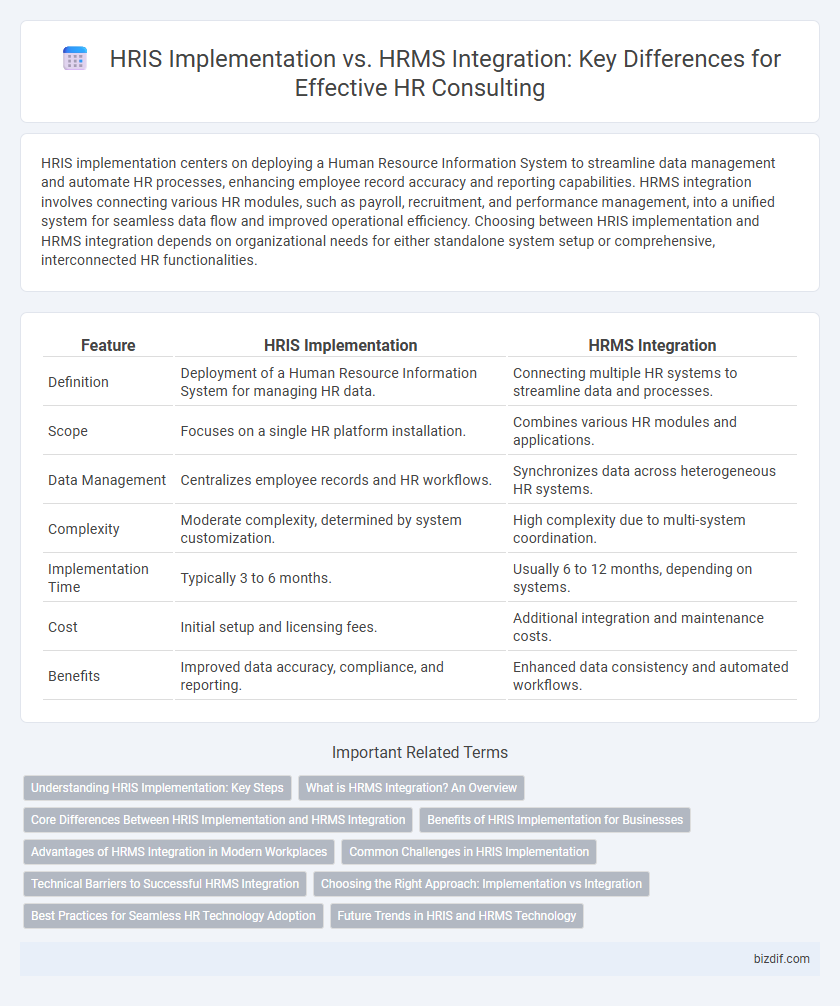HRIS implementation centers on deploying a Human Resource Information System to streamline data management and automate HR processes, enhancing employee record accuracy and reporting capabilities. HRMS integration involves connecting various HR modules, such as payroll, recruitment, and performance management, into a unified system for seamless data flow and improved operational efficiency. Choosing between HRIS implementation and HRMS integration depends on organizational needs for either standalone system setup or comprehensive, interconnected HR functionalities.
Table of Comparison
| Feature | HRIS Implementation | HRMS Integration |
|---|---|---|
| Definition | Deployment of a Human Resource Information System for managing HR data. | Connecting multiple HR systems to streamline data and processes. |
| Scope | Focuses on a single HR platform installation. | Combines various HR modules and applications. |
| Data Management | Centralizes employee records and HR workflows. | Synchronizes data across heterogeneous HR systems. |
| Complexity | Moderate complexity, determined by system customization. | High complexity due to multi-system coordination. |
| Implementation Time | Typically 3 to 6 months. | Usually 6 to 12 months, depending on systems. |
| Cost | Initial setup and licensing fees. | Additional integration and maintenance costs. |
| Benefits | Improved data accuracy, compliance, and reporting. | Enhanced data consistency and automated workflows. |
Understanding HRIS Implementation: Key Steps
HRIS implementation involves deploying a centralized software system designed to manage employee data, streamline payroll, benefits administration, and compliance tasks within an organization. Key steps include needs assessment, system selection, data migration, user training, and ongoing support to ensure seamless adoption and functionality. Proper planning and stakeholder engagement during HRIS implementation reduce errors, enhance efficiency, and improve HR decision-making accuracy.
What is HRMS Integration? An Overview
HRMS Integration refers to the seamless connection of Human Resource Management Systems with other enterprise software to centralize data management, improve accuracy, and enhance workflow efficiency. It enables automated synchronization of employee information, payroll, benefits, and performance metrics across multiple platforms, reducing manual errors and operational costs. This integration supports real-time data access and reporting, empowering HR teams to make informed decisions and optimize talent management strategies.
Core Differences Between HRIS Implementation and HRMS Integration
HRIS implementation primarily focuses on deploying a centralized system for managing employee information, payroll, and compliance, emphasizing data accuracy and streamlined HR processes. HRMS integration involves connecting multiple software modules such as recruitment, performance management, and benefits administration to create a unified platform that enhances workflow efficiency. The core difference lies in HRIS being a standalone system installation, while HRMS integration encompasses combining diverse HR functions into a cohesive digital ecosystem.
Benefits of HRIS Implementation for Businesses
HRIS implementation streamlines employee data management by centralizing payroll, attendance, and benefits information into a single, accessible platform, reducing administrative errors and saving time. It enhances decision-making through real-time analytics and reporting, enabling HR teams to track workforce trends and optimize talent management strategies effectively. Businesses gain improved compliance with labor laws and data security standards, minimizing risk and fostering a more organized, efficient human resources function.
Advantages of HRMS Integration in Modern Workplaces
HRMS integration streamlines employee data management by unifying recruitment, payroll, performance, and benefits systems into a single platform, reducing administrative errors and saving time. Enhanced real-time analytics and reporting capabilities foster data-driven decision-making, improving HR strategy and workforce planning. Seamless integration with third-party applications ensures scalability and adaptability to evolving business needs, supporting modern workplace agility and employee experience.
Common Challenges in HRIS Implementation
Common challenges in HRIS implementation include data migration complexities, user resistance to change, and inadequate training, which can hinder system adoption and efficiency. Ensuring seamless integration with existing payroll and benefits systems often requires extensive customization and technical expertise. Security concerns and compliance with data privacy regulations further complicate the implementation process, necessitating robust access controls and regular audits.
Technical Barriers to Successful HRMS Integration
Technical barriers to successful HRMS integration include data incompatibility between disparate systems, resulting in synchronization issues and data loss. Lack of standardized APIs and protocols hinders seamless communication, increasing implementation complexity and maintenance costs. Additionally, insufficient IT infrastructure and cybersecurity vulnerabilities pose significant risks during the integration process, delaying deployment and reducing overall system efficiency.
Choosing the Right Approach: Implementation vs Integration
Choosing the right approach between HRIS implementation and HRMS integration depends on the organization's current infrastructure and scalability needs. HRIS implementation offers a comprehensive, standalone solution tailored to streamline HR processes, while HRMS integration enhances existing systems by connecting various HR modules for real-time data synchronization. Assessing factors such as data migration complexity, system compatibility, and long-term maintenance helps in determining whether a full implementation or strategic integration will maximize operational efficiency and ROI.
Best Practices for Seamless HR Technology Adoption
Effective HRIS implementation requires thorough needs assessment and stakeholder engagement to tailor the system to organizational goals, enhancing user adoption and data accuracy. HRMS integration best practices emphasize seamless connectivity between disparate modules like payroll, recruitment, and performance management to streamline workflows and ensure real-time data synchronization. Prioritizing comprehensive training programs and continuous support maximizes employee proficiency and mitigates resistance, fostering a smooth transition to advanced HR technology solutions.
Future Trends in HRIS and HRMS Technology
HRIS implementation is evolving with AI-driven analytics and cloud-based platforms enabling predictive workforce planning and enhanced employee experience. HRMS integration increasingly incorporates machine learning for automated talent management and seamless payroll synchronization across global operations. Future trends emphasize adaptive systems offering real-time data insights, mobile accessibility, and robust cybersecurity to meet dynamic organizational needs.
HRIS Implementation vs HRMS Integration Infographic

 bizdif.com
bizdif.com